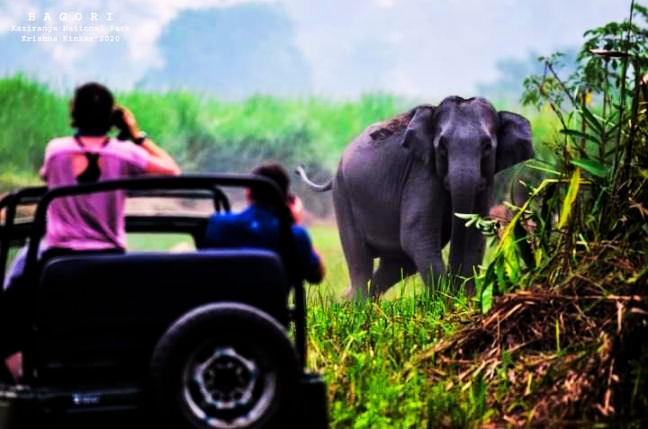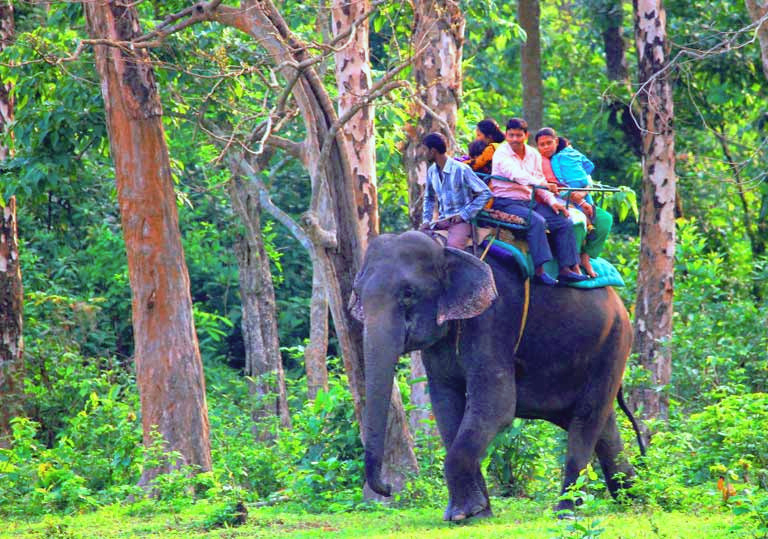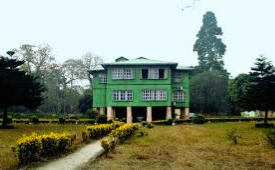Jaldapara
National Park
Jaldapara Public Park is a public park in northern West Bengal, India, located on the banks of the Torsa Stream and at the foot of the Eastern Himalayas. Jaldapara has a height of 61 metres and a land area of 216.51 square kilometres (83.59 square miles) with patches of riverine woodlands. It was designated a natural life safe haven in 1941 to protect its diverse vegetation.
The recreation area currently has the largest population of Indian one-horned rhinoceroses in the state, a threatened species, and serves as an environment the executives region.
The nearby Chilapata Timberlands serve as an elephant passageway connecting Jaldapara and the Buxa Tiger Hold. The nearby Gorumara National Park is also well-known for its wildlife.

Jeep Safari
Take wilderness jeep safari by open in search rhinos , elephants, monkeys , wild pigs,leopard,sambar,barking deer,bison.....

Elephant Safari
The Famous Jaldapara Wildlife Elephant Safari Ride, the one thrilling experience no deserving tourist can miss in their lifetime.

Hotel Booking
Numerous lodging options, ranging from budget-friendly to luxurious, are offered close to Jaldapara National Park to accommodate visitors.
History of Jaldapara National Park
Jaldapara National Park is one of the deepest forests in India. The national park is famous for One Horned Indian Rhinoceros and Elephants. The park covers a forest area of 216.51 km2, which is surrounded by lush green forests and wild animals. It is located on the banks of the river Torsa in the Alipurduar district of West Bengal, India. Since 1941, the Government of India has declared it a sanctuary for the conservation of flora and fauna. But later in 2012 the sanctuary was declared a national park. Also found are various species of plants, insects, reptiles and birds.
Safari in Jaldapara National Park
The rich vegetation cover and dense jungle of Jaldapara National Park makes it the natural habitat of a number of wild animals. It is home to the largest population of Asian one-horned rhino, elephants, bison, spotted deer, sambar deer and many more. Venturing deep into the jungle is one of the first things to do for the tourists. Jeeps and elephants are the only ways to enter and explore the forest. Elephant safaris are preferred for they are able to enter deep into the jungle, areas which cannot be accessed by jeeps. It also gives a better view of the surrounding forests. They are organized early in the morning. Jeep safaris are available both in the morning and in the afternoon and both give a unique experience to visitors.
Safari Zones in Jaldapara
Lorem ipsum dolor sit amet, consectetur adipiscing elit. Ut elit tellus, luctus nec ullamcorper mattis, pulvinar dapibus leo.
Jeep Safari in Jaldapara
Lorem ipsum dolor sit amet, consectetur adipiscing elit. Ut elit tellus, luctus nec ullamcorper mattis, pulvinar dapibus leo.
Elephant Safari in Jaldapara
Lorem ipsum dolor sit amet, consectetur adipiscing elit. Ut elit tellus, luctus nec ullamcorper mattis, pulvinar dapibus leo.
Best Time to Visit Jaldapara
The weather experienced in Jaldapara National Park is typically tropical. The summer is very hot and humid (March – June), and cold nights in winters (October – March). The rainy season starts from 16th June and continues to 15th September. Park remains closed during this season. The months of November to April are the best time to visit Jaldapara National Park
Summer (March - June)
Summer in Jaldapara gets hot, sultry and humid. Temperatures continue to hover between 32° and 40°C. Summer is a good time to visit if you want to spot wild animals. Due to the heat, they often come out of their hideouts and can be found roaming around the park. Spotting is relatively easier. Early in the morning or just before dusk when animals come near the water bodies to drink water are the best times to spot them. As temperature increases during the day time to prefer to take shelter in cooler areas. If you want to visit Jaldapara during summer you must be willing to sweat out a little but it is definitely worth it. Carry light clothes and hats to protect yourself from the heat.
Monsoon (June - September)
Jaldapara experiences heavy monsoon showers between June and September and the park remains closed to tourists. All national parks remain closed during monsoon because safaris are difficult and there are negligible chances of spotting animals. Monsoons are generally breeding time for the animals and they prefer to remain in their shelters and do not venture out much. Safaris are thus not undertaken during these months. Incessant rains and thunderstorms make traveling and sighting challenging and there is nothing much to do unless tourists want to experience rains in the forest.
Winter(October - March)
Mid-September to October is the period right after the monsoons when the leaves are fresh and green. The grasslands grow in height during monsoon rains making the forests denser than ever. Animals hide behind these overgrown grasses and spotting becomes difficult unless they choose to come out in the open. This period also witnesses occasional showers which make safaris difficult. The better time to visit Jaldapara is between November and March. The trees shed leaves, the grasses tend to get thinner and the weather also improves vastly. It is cool and pleasant; the skies are clear and cloudless and this is the perfect time for paying a visit to the jungles and chances of spotting animals are also high.